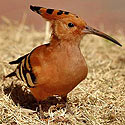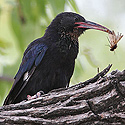|
Order: Upupiformes (hoopoes, wood-hoopoes,
scimitarbills)
Life
> Eukaryotes >
Opisthokonta
> Metazoa (animals) >
Bilateria >
Deuterostomia > Chordata >
Craniata > Vertebrata (vertebrates) > Gnathostomata (jawed
vertebrates) > Teleostomi (teleost fish) > Osteichthyes (bony fish) > Class:
Sarcopterygii (lobe-finned
fish) > Stegocephalia (terrestrial
vertebrates) > Tetrapoda
(four-legged vertebrates) > Reptiliomorpha > Amniota >
Reptilia (reptiles) >
Romeriida > Diapsida > Archosauromorpha > Archosauria >
Dinosauria
(dinosaurs) > Saurischia > Theropoda (bipedal predatory dinosaurs) >
Coelurosauria > Maniraptora > Aves
(birds)
Families indigenous to southern Africa
|
Upupidae (Hoopoe)
A single species, the African
hoopoe Upupa africana.
The African hoopoe is a very widespread range, found
everywhere in southern Africa except deserts, karoo and, strangely, Lesotho.
It mainly lives in tall woodlands with short cut grass undergrowth, but it
has also adapted well to living with humans, and can be found in many urban
areas. It feeds on insects, probing the ground with its bill. It often nests
in tree holes up to 8m above ground, as well as a number of man-made
structures. It lays 4-7 eggs, which are incubated exclusively by the female.
The chicks stay in the nest for 26-32 days before leaving the nest for the
surrounding foliage. They remain dependent on their parents for at least 1
month before becoming fully independent.
|
 |
|
Phoeniculidae (wood-hoopoes) |
 |
|
Rhinopomastidae (scimitarbills)
One species: Common
scimitarbill Rhinopomastus cyanomelas
The Common scimitarbill is a common bird in the top 3
quarters of southern Africa, living in tropical or subtropical arid
woodland, favouring miombo and Mopane trees. It feeds almost exclusively on
insects, running up and down trees, probing the bark with its bill. It uses
natural or barbet/woodpecker made holes in trees as nests. It lays 2-4 eggs,
which are incubated solely by the female, for 13-14 days. The chicks fledge
at 21-24 days, after which they leave the nest. The fledglings first flight
is usually 10-50 m long.
|
 |
|
